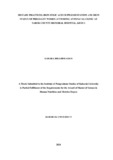DIETARY PRACTICES, IRON FOLIC ACID SUPPLEMENTATION AND IRON STATUS OF PREGNANT WOMEN ATTENDING ANTENATAL CLINIC AT NAROK COUNTY REFERRAL HOSPITAL, KENYA
Abstract
Iron deficiency anaemia is one of the most prevalent nutritional deficiencies during pregnancy. Globally, there are an estimated 56 million anaemic women, with 75–80 percent suffering from iron deficiency anaemia. In Kenya, 48% of reproductive-age women suffer from anaemia. This proportion is higher among pregnant women from Arid and Semi-Arid Land. Minimal studies have been conducted on how dietary diversity influence the iron status of pregnant women especially among pregnant woman from Arid and Semi-Arid Land. This study sought to assess dietary diversity, iron folic supplementation and iron status of pregnant women attending antenatal clinic at Narok County Referral Hospital.This research adopted a cross-sectional analytical study design. The accessible population were all the women attending the antenatal clinic in Narok County Referral Hospital. The target sample was 192 while 178 pregnant mothers responded to the study. Narok county and Narok County Referral Hospital were purposively selected. Systematic random sampling was used to select the sample. The researcher administered a questionnaire and Key informant interviews were used to collect data. Data was cleaned and analysed by use of Statistical Package for Social Sciences Software Version 24. Descriptive statistics was used to describe the data. Chi square and Pearson correlation were used to show the association between categorical and non-categorical variables. Odds ratio was used to determine the likelihood of iron deficiency as influenced by the dietary diversity. AP values of <0.05 was used. Data from Key Informant Interview's was transcribed, coded and analysed to generate emerging common themes established. The study revealed that most of the pregnant women (44.4%) were aged 18-24 years, married (71.3%) and were in small businesses (52.2%). Most (68%) of pregnant women consumed four meals a day. The results revealed that the nutrient intake levels of the respondents was generally below recommendation since57.9% of pregnant women did not meet the minimum women dietary diversity score. About (68.5%) of the respondents were taking Iron Folic Acid supplementation with only 13.5% of respondents having adhered to the recommendation. The average HB levels were11.75±1.35with 52.2% having low haemoglobin levels of below 12g/dl. Marital status, parity, number of children and occupation were not associated with iron status. The study concluded that iron status of most mothers was low as evidenced by the low levels of haemoglobin. In order to reduce maternal anaemia, the study recommends more sensitization to be done by health workers.

